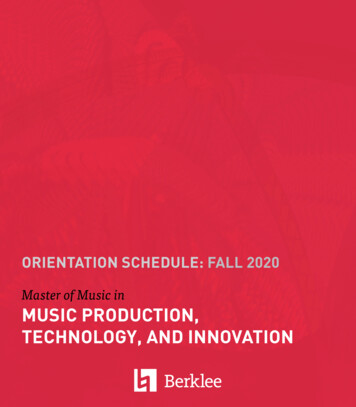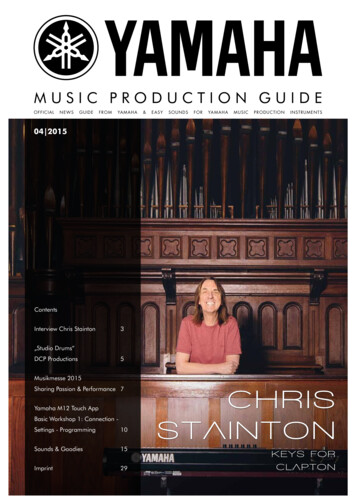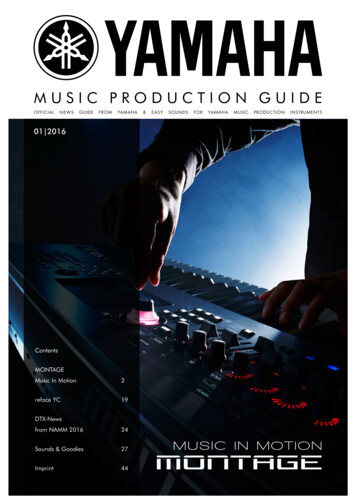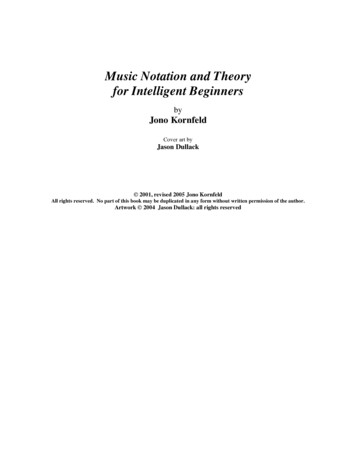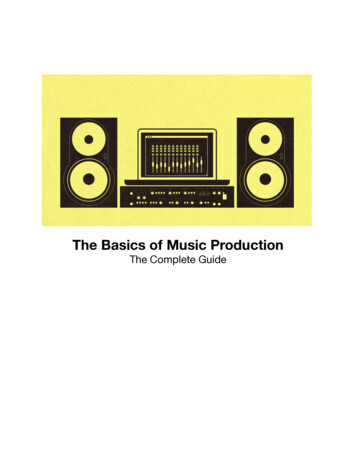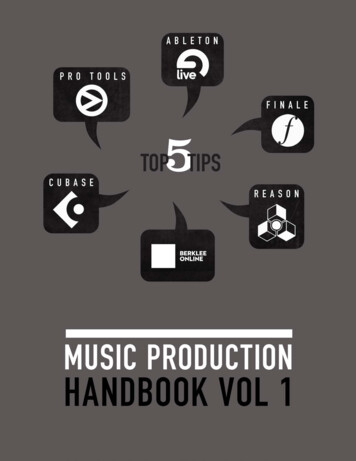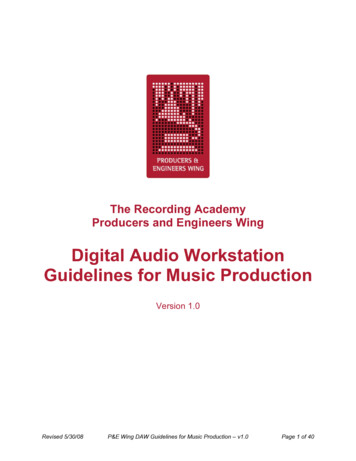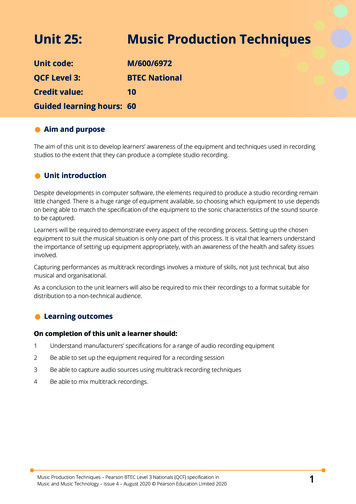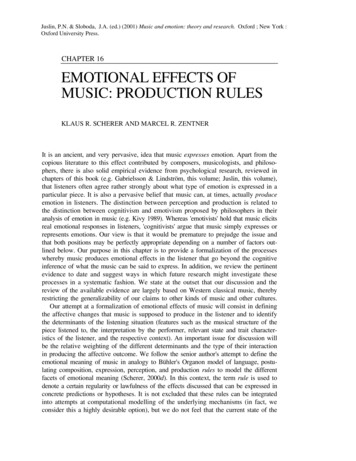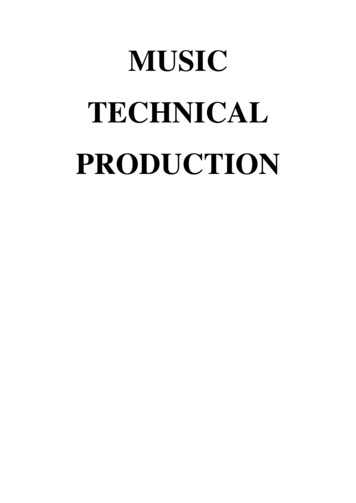
Transcription
Beginners Guide To Music ProductionIt’s MusicTech’s guide to everything you need to know about music production: fromrecording to mixing to mastering. Welcome to our Beginners GuideAre you new to music production? Or are you returning to music making and need a refresher in certainaspects of recording, mixing and mastering? If either of these applies, then you’ve come to the right place.We’re going to explain all of the main principles of music technology and music production in asstraightforward a way as possible.Read the following and you should be in a good place to start (or restart) your music making, whether as ahobby, semi-professionally or even as a career.So Where Do We Start?The basics of a composition or song are its constituent parts i.e. the instruments (guitar, drums, bass,
keyboards and so on) and the vocals. These are the ‘tracks’ and the core of the music production process issimply how you get the sounds together for each track, arrange them, mix them together and make themsound ‘professional’.The device that enables all of this – and which has become the heart of the 21st century studio – is thehumble computer: a Mac, PC or increasingly, portable devices like tablets and iPads.Sequencers/DAW‘sMore specifically, of course, it’s the software that the computer runs that turns it in to a music productionpowerhouse. This software enables the recording, mixing and mastering of music tracks and is called a‘sequencer’ or the rather grander-sounding ‘Digital Audio Workstation’ (DAW).Sequencers vary in price from free to hundreds of pounds and, combined with today’s powerfulcomputers, can often allow unlimited tracks of music to be arranged together. You want an orchestra ofthousands? You’re mad, but you’ve got it Waveform editing in the Cubase environment – one of the DAW industry leaders
SoundsSo where do the sounds come from and how do you get them together within your computer? It’s easiestto think of these as ‘internal’ and ‘external’ within the context of your desktop environment. You canrecord ‘external sounds’ – guitars, vocals, acoustic instruments such as pianos and violins, or electronickeyboards like synthesizers – and arrange them together in your sequencer.These are ‘digital audio’ tracks – no need to worry too much about the name just now, but it does becomeimportant later. They contain the actual audio information, the recorded waveform of the externalinstrument.
Three of the Big Six: Cubase , Reason and Pro ToolsNow to the internal sounds, sounds generated within your DAW. Most sequencers have what are called‘virtual instruments’ that recreate, for example, drum kits, keyboards or guitars for you to play or strumwith your mouse or a connected keyboard.These are known as MIDI tracks. Again you don’t need to worry too much about semantics here but thedata within a MIDI track is more about the note information (which notes are played, how hard and forhow long). These notes can be moved around and edited after being recorded simply by using thesequencer’s editor, clicking on them and dragging them around on screen.The second type of internal sound is called a sample. Again these are audio, so digital recordings of realsound but they are especially-created riffs, melodies, drum patterns (loops), or vocal parts produced bythird party manufacturers. You can buy collections of these (on CD, DVD or download – or get them freewith MusicTech each month!) and simply drop them on different tracks to build up a tune.
The rest of the Big Six: Ableton Live , Logic and FL Studio. The premiere DAWs/SequencersSo, three different ways of getting sounds together for song creation. You can now create songs usingexternal sounds, virtual instruments and samples or, more likely, a combination of all three. In theory,that’s all you need to know to go and produce music but there’s more if you want it, so let’s delve a littledeeper and look at each method a little more closely 1. Recording External SoundsWhen we talk about ‘recording’ these days what we generally mean is the process of getting externalsounds – vocals and instruments – into a computer. This could simply be a matter of pointing an iPad micat a guitarist and pressing record (not the best quality) or recording individual members of a bandsimultaneously using an ‘audio interface’. This interface is a key part of music technology. It is requiredbecause most computers simply don’t have the right connections for you to go plugging a band orinstruments into, so your interface might allow your drummer, guitarist, bass player and vocalist to plugdirectly into your computer and play and record into the tracks of your sequencer.
There are many great apps available for your mobile devices and tablets, check out our listGenerally when you record a band in your studio you record one track at a time (your guitarist playingover the already-recorded drum part, for example). But with computer power as it is and with interfacescapable of recording many instruments simultaneously, there’s no reason why you can’t record a band’sentire live performance, each track recorded individually but at the same time, with one computer and asuitable interface.The quality of the interface is also a key point because you want to get the best quality recordings of eachinstrument into your computer. Start with a high quality recording and you will have to do less later on inthe mixing process. This is where things get a little techy as the process of recording external signals into acomputer means that you are converting analogue signals into digital ones, so a good analogue to digitalconverter is required. Without wishing to get too geeky look out for 24-bit 96kHz interfaces.i) Interface types So you can plug your instruments and microphones into interfaces to record them buthow do these interfaces plug into your computer? Many utilise the USB socket which handles audio datano problem. More channels (inputs and outputs) may require that you use the computer’s Firewireconnection and there are adaptors to convert Firewire to the newer Thunderbolt connections.ii) Improving the input signal As we’ve said signal quality is key – put garbage in, you’ll get garbage out. Soanother key component in your signal chain is the microphone pre-amp, specifically for, no surprise here,microphones. If you are recording a band or lots of vocalists your may need mic preamps to make sure
that the signal you are recording is good enough. Many audio interfaces have mic preamps built-in so youcan increase the level of it is weak.RULE! A key component in your studio is the interface. Invest in a good one to record anddeliver the best quality external sounds to your sequencer.Getting yourself a decent interface is essential – Focusrite’s Scarlett range are interface industry leadersiii) Improving the signal again!In the olden days mixing desks were used to record and featured extra elements to manipulate the inputsignal like EQ (to adjust the bass and treble); the aforementioned mic preamp; compression (to reduce thehighs and lows of a signal so that it can be raised in perceived volume – more on this later); and noisegates (so stop ‘hiss’).With most of the mixing now done inside the computer (see later) actual proper mixing desks arebecoming rarer but ‘channel strips’ are becoming increasingly popular to emulate individual channels of amixer so you can apply compression, noise gating, EQ and preamps to individual instruments as yourecord their signals into your computer. Many channels strips are based on classic (read ‘expensive’)
mixers which were used in the analogue heyday of recording (the 60s and 70s) and deliver a classicanalogue character to your signal.Be warned: you can (and arguably should) spend a lot of money on decent quality interfaces and channelstrips.RULE! Getting the best signal in to your computer is vital. Make sure you put aside a largerportion of your budget aside for a decent interface and channels strip or combination of thetwo.So that’s the outside world of music taken care of. With a decent interface you can mic up and plug invocalists and instruments into your computer and record them. You now have track after track of theseexternal audio tracks to play with and mix. Time to look inside your computer and see what’s on offerthere to go with them 2. Using Internal Sounds: Virtual InstrumentsIn theory you don’t have to record anything from the outside world at all if you don’t want to. Grab alaptop with a sequencer full of virtual instruments and you can do it all yourself, or at least give it a go.Virtual instruments offer versions of pretty much every instrument you can imagine and a lot you can’t.They can recreate a guitar, piano, synth or drum kit within your sequencer environment all played andrecorded using your computer’s mouse, or a MIDI keyboard/controller.This virtual instrument technology has opened up different worlds of music making to whole newaudiences so even if you can’t play a note on a ‘proper’ instrument, virtual instruments allow you to strum,pick, hit, tap and play, all within the safety of your virtual studio.
Forest Kingdom II – A typical example of a MIDI-based Virtual InstrumentVirtual instruments have been with us for some years now and are fairly straightforward to program sothere are gazillions out there. Pretty much every classic hardware synth and instrument has beenemulated over the years as have many instruments that have never existed. In fact it’s fair to say that thereis a mind-boggling choice. Thankfully most sequencers now come with a good selection of virtualinstruments which cover a lot of bases, so if you choose one of the big six DAWs (Cubase, Logic, Pro Tools,Reason, FLStudio and Ableton Live) you will have more than enough virtual power at your fingertips.However if you want to sound different from everyone else then you might want to consider the manyothers that are available. We’ll have a buyers guide here soon including some of the top 10s in differentcategories so be sure to check back.3. Using Internal Sounds: SamplesThere are many, many companies that produce ready made samples of instruments, drum loops, andvocal lines for you to buy and drop into your music creations. There used to be a bit of snobbery aboutusing samples but not so these days – in fact many a tune (and indeed genre) has been based on theinclusion of great samples.
You can buy collections of samples based on literally anything you can imagine because everything thatcan be recorded probably has been recorded and is available. Dance music has beats, basses and leads forevery genre. All other genres are catered for and there are collections based on obscure instruments andcultures from every corner of the world. Instrument samples like these can also be loaded into softwaresamplers where they can then be mapped across a keyboard and then ‘played’ adding another level offlexibility to sample use.Sample collections are great as a quick fix and especially useful if you are working on many differentpieces of music against tight deadlines. If you want to try some samples out for free MusicTech magazinehas collections available on its DVD every month. You can also find an exclusive collection here so have aplay and see how you get on. You might find that they act as the bare bones of your tracks and then youflesh them out later with VIs and external recordings. Either way they are a fast and quick ingredient andit’s well worth having at look at some of the collections available.4. MixingOK, by now we’re assuming you’ve got your head around how you get sounds into your sequencer,generate them from within it or use sample collections. The next stage is to arrange them and mix themtogether. Arranging is simply the process of how your song develops over time, usually with an introfollowed by verses and choruses. Discussing the different aspects of arrangements could be a website initself as each arrangement depends on the genre you are working within, but mixing is a subject that wecan cover, albeit on a simple level, right here and right now.Try to think of your song mix in two dimensions: how it spreads across the stereo spectrum (left to rightacross your speakers or headphones) and how it spreads across the frequency range (think bottom, bass,to top, treble). Generally speaking having a good spread in both dimensions is the key. You don’t want atoo bass-heavy mix in the same way that you do not you want everything coming out of just your leftspeaker.In terms of stereo placement the panning controls in your sequencer track channels allow you to placeeach track anywhere between far left and far right. The rule is the bassier the track the more central it is sobass-lines of tracks tend to sit in the middle of the stereo spectrum acting as the backbone of a track. Thevocal can sit close to it as its higher frequency allows the vocal to still be apart from the bass and this is arule you can follow (although you don’t have to!): instruments can sit with each other in the same stereoposition as long as their frequencies don’t clash too much. Feel free to experiment though, move thingsaround, and if it sounds good it is good! And don’t be afraid to EQ certain parts of a track to make them sitbetter and not clash against other parts.Effects For Mixing
As well as virtual instruments most sequencers come packed with stacks of virtual effects, many of whichyou can use in the mixing process. We’ve discussed how EQ can lift or lower the impact of certainelements in a mix. Effects such as reverb can make parts of your mix sound like they have been recordedin different rooms by adding reflective echoes. Echoes themselves can make parts repeats while chorusand harmony effects add additional melodic content.It can be easy to get overwhelemed when using too many effects!More creative effects include amp simulators that can be, for example, applied to acoustic guita
This software enables the recording, mixing and mastering of music tracks and is called a ‘sequencer’ or the rather grander-sounding ‘Digital Audio Workstation’ (DAW). Sequencers vary in price from free to hundreds of pounds and, combined with today’s powerful computers, can often allow unlimited tracks of music to be arranged together. You want an orchestra of
